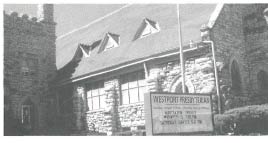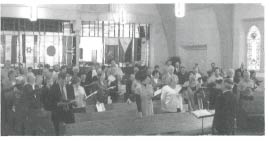Updated April, 2025
Walking into the office of Scott Myers, the pastor of Westport Presbyterian Church, one is surrounded by books. In and of itself this is not unusual. What is distinctive about Myers’s office is that alongside the theological writings stands a significant collection of books on the visual arts. Rodin and Chagall, photography, painting, and sculpture all occupy prominent places both on his bookshelves and in the worship life of the church he serves in the historic district of Westport, Missouri.
The church was founded in 1835 in the days when westward expansion followed the path up the Missouri River from St. Louis and proceeded on by wagon train, using Kansas City as a staging post along the way. Today Westport is a vibrant urban area in the center of Kansas City replete with restaurants and small shops that attract visitors throughout the region.
Worship as Art
As the leaders and membership of Westport Presbyterian Church struggled with the question of how to serve a cosmopolitan, diverse congregation, they decided to focus their attention on the integration of the arts into their worship life and ministry. For many congregations, a decision like this might mean simply looking for places to incorporate sacred dance, drama, or visual art into their existing worship services. Westport Presbyterian took a somewhat different approach. Rather than beginning with the intention of adding art to worship, they decided to first think about what it means to consider worship as art. Myers writes,
The church has found that communicating the Christian message and philosophy through the arts—a subtle, indirect approach to ministry—appeals to both long-time church members and non-churchgoing, urban people. Firm believers, non-believers, seekers, doubters, and questioners—Protestants, Catholics, Jews, and even a Muslim woman and her Hindu husband from India—have been encouraged to “try out” a Christian ministry that encourages them to open their minds, share their thoughts, and consider the soul’s relationship to God and the contemporary human condition, all through the arts!
Indeed, worship itself became an art form to be molded and shaped in order to better communicate the Christian gospel.
This spirit of integration that envelops different cultural and artistic traditions in the context of worship and ministry began in 1994—the year both Scott Myers and Marian Thomas, the church’s music director/organist, were hired. Since that time an arts committee comprised of congregation members and friends of the congregation has been established to coordinate the church’s burgeoning arts ministry. Under the leadership of Myers and Thomas, and with the support of the congregation, Westport Presbyterian Church has developed of a variety of different projects—each of which has been given a distinctive name.
Art ’n Soul is a centerpiece of this effort. Myers describes it this way:
Art ’n Soul is a kind of visual sermon, or contemporary illuminated manuscript, combining the reading of Scripture and interpretation with the display on a large screen of paintings, sculpture, photographs, stained glass windows, lithographs, drawings, tapestries, murals, and frescoes from ancient times to the present and from all world cultures and nations.
In a typical Art ’n Soul presentation a Scripture passage is coupled with short commentaries written to expand on each verse of the passage. Two voices are employed to read alternatively the Scripture and the commentaries, while a PowerPoint presentation projects art works that illustrate and visually comment on the text. A variety of different Art ’n Soul presentations have been created to date, including The Lord’s Prayer, Holy Week/Easter, Pentecost, The 23rd Psalm, The Parable of the Sower, The Beatitudes, and a compilation entitled The Life of Jesus. Christmas Eve services represent an especially poignant setting for this ministry as the entire service consists of an Art ’n Soul retelling of the Christmas narrative. Future plans include presentations on the creation story and on a psalm in celebration of music.
The visual arts also play other roles in worship. On a regular basis visual art is featured on the cover of worship bulletins. This extends from children’s art to the works of professional artists and historic artwork. In addition, commentary on artwork is sometimes incorporated into the sermon. A rotating art display is present in the narthex. Finally, one other special visual dimension of worship is the presentation of flags from many countries around the world on World Communion Sunday.
Soul’s Window
In recent years a new worship service has begun on Saturday evenings entitled Soul’s Window. This service is more informal than Sunday morning and is held in the large narthex of the church. As Myers points out, this service “deliberately explores important spiritual, ethical, and simply human themes with the aid of art, music, photography, film, and movement.” Themes that have been explored in the past include How Can I Be Forgiven?, What Is the Meaning of the Cross?, How to Talk About God Without Using the Word “God,” How Is Justice Created Out of Injustice?, and How Do We Deal with Shattered Peace?

A recent service illustrates the character of a typical Soul’s Window worship service. Upon arriving, each participant in the service pours water into a water sculpture—a full cup with a fountain overflowing from its side. This is a way for worshipers to physically enact and recall the blessings God has given them as embodied in the words of Psalm 23 —“my cup runneth over.”
Following this, everyone who comes to worship is presented with a photography book to use during the service. The book’s subject matter ranges from photographs taken during the depression in the 1930s through contemporary photographs, most of which involve human subjects in some way. The theme for this particular service is printed at the top of the worship bulletin: “How is it that intolerance, selfishness, and hate often trump tolerance, selflessness, and love?” As worshipers gather they are given time to meditate on this theme and to find photographs that illustrate it in some way.

Sitting in a circle, the congregation begins the service by passing around a medicine wheel, a tradition borrowed from Native American culture. As each participant receives the wheel she may express her thoughts briefly. This enables worshipers to bring their entire selves into the service with them—to connect their lives outside worship with worship itself. Hymns and Scripture related to the theme of the day are employed throughout the hour-long service. In between these hymns, worshipers are invited to share reflections on the photographs they have selected. Ample time is allowed for prayer and meditation. The service concludes with participants joining hands and receiving final blessings.
Cinema ’n Soul
This is but one example of the many different artistic elements that are integral to this worship service. Every Soul’s Window service features art of some kind: poetry and photography by members of the congregation or even film clips as they relate to the day’s theme (Churches who show film clips will need to make sure they comply with copyright law. See Christian Video Licensing International, www.cvli.org for information.) Film has, in fact, been an important part of the life of the congregation, both within this service and at other times. For example, the conclusion of the Good Friday service each year features the screening of a complete film as an extension of the worship service. This year, the film Cry the Beloved Country was selected to illustrate the theme of forgiveness. This film ministry is called Cinema ’n Soul. It originally began in 1998 with a 24-inch television and a VCR. Since that time it has expanded to use a large movie screen and a digital projector. According to Myers,
All the films contain spiritual, ethical, and “meaning of life” themes. They have created space for “city folks” who range from committed Westport church members to doubters, seekers, and even non-believers to be exposed to films that have the instant and/or cumulative effect of enlarging the viewer’s window on the realm of the Spirit and the life of the individual soul in the contemporary world.
Choir Sunday
Music also has an innovative role to play in worship. Once a month the congregation celebrates “choir Sunday.” At these services a new hymn is introduced to the congregation; everyone is invited to join the choir during a rehearsal prior to the service to prepare this new hymn. Marian Thomas says that the idea of a hymn choir began one summer during the two months the regular choir is on vacation; people liked the idea so much they asked to continue it all year. This connection to the church’s hymnody is made explicit through weekly bulletin notes about the hymns written by Thomas, who recently retired from the Saint Paul School of Theology, a United Methodist Seminary in Kansas City, where she served as director of music and taught a course in hymnody.
The church’s ever-expanding repertoire of congregational song often includes multicultural music. Recently the church sponsored a special event led by John Thornburg that was designed to further invigorate congregational singing.
Musicians who perform without fee at free mid-week Brown Bag Concert Series events sponsored by the church are often subsequently hired to share their gifts on Sunday mornings as well. These include classical artists from the Kansas City Symphony, the Kansas City Chorale, the University of Missouri at Kansas City Conservatory of Music, the Kansas City Civic Opera, and jazz and folk artists from the surrounding area.
Churches often mistakenly think that large congregations with significant budgets are the only ones that can engage in creative and innovative programming. Westport Presbyterian Church is a shining example of what can happen in a smaller congregation. This church of 85 members has been a leader in the Kansas City community, standing as an example of the possibilities inherent in the union of worship and the arts. This coming year, Pastor Myers will have the opportunity to expand this vision even farther as he embarks on a sabbatical (funded by the Lilly Endowment Clergy Renewal Program). The sabbatical will enable Myers to create new Art ’n Soul presentations, explore the inclusion of movement and dance into worship, and travel to Christian arts retreats in this country and to sites in Europe in search of new ideas.
Rev. Myers sums up the efforts of his congregation’s arts ministry as follows:
The lesson of the church’s experience these past ten years is that worship services that communicate the Christian message through the arts are especially effective, and that they continue to be a catalyst to shaping even more clearly Westport Presbyterian Church’s identity as an urban center of spiritual arts and renewal.
